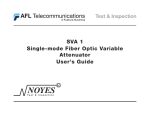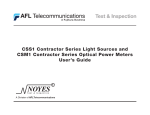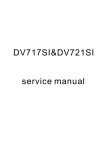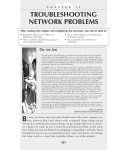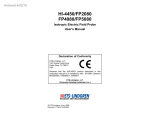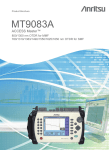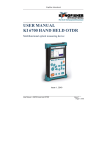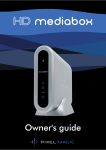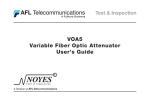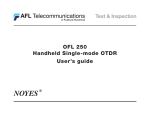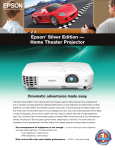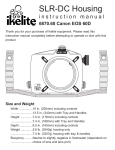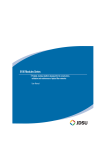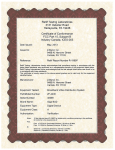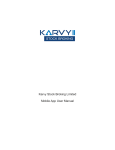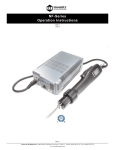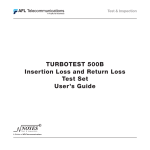Download M200 Handheld OTDR User`s Guide
Transcript
M200 Handheld OTDR User’s Guide Test & Inspection Limited Warranty One Year Limited Warranty All Noyes products are warranted against defective material and workmanship for a period of one year from the date of shipment to the original customer. Any product found to be defective within the warranty period will be repaired or replaced by Noyes. In no case will Noyes liabilities exceed the original purchase price of the product. Exclusions The warranty on your equipment shall not apply to defects resulting from the following: • Unauthorized repair or modification • Misuse, negligence, or accident CE Information These instruments have been designed and tested to comply with the relevant sections of any applicable specifications including full compliance with all essential requirements of all applicable EU Directives. Returning Equipment To return equipment, please contact Noyes to obtain additional information and a Service Request (S.R.) number. To allow us to serve you more efficiently, please include a brief description specifying the reasons for the return of the equipment. AFL Telecommunications Noyes Test & Inspection 16 Eastgate Park Road Belmont, NH 03220 Tel: 800-321-5298 603-528-7780 Fax: 603-528-2025 This is a quick reference user’s guide for the M200 OTDR. It assumes basic knowledge in the use of an OTDR and a PC. 2 Table of Contents Safety Information . . . . . . . . . . . . . . . . . . . . . . . . . . . . . . . . . . . . . . . . . . 4 Getting Started: M200 Keys . . . . . . . . . . . . . . . . . . . . . . . . . . . . . . . . . . . 5 Getting Started: Display Features . . . . . . . . . . . . . . . . . . . . . . . . . . . . . . . 6 Set-up: General Settings . . . . . . . . . . . . . . . . . . . . . . . . . . . . . . . . . . . . . 7 Home Page: Changing the Mode . . . . . . . . . . . . . . . . . . . . . . . . . . . . . . . . 8 Set-Up: Full Auto Mode Settings . . . . . . . . . . . . . . . . . . . . . . . . . . . . . . . . 9 Set-Up: Live Mode Settings . . . . . . . . . . . . . . . . . . . . . . . . . . . . . . . . . . . 10 Set-up: Expert Mode Settings . . . . . . . . . . . . . . . . . . . . . . . . . . . . . . . . . . 10 Set-up: Expert - Manual Setup . . . . . . . . . . . . . . . . . . . . . . . . . . . . . . . . . 11 Set-up: Events Menu Settings . . . . . . . . . . . . . . . . . . . . . . . . . . . . . . . . . . 11 File Manager . . . . . . . . . . . . . . . . . . . . . . . . . . . . . . . . . . . . . . . . . . . . . . 12 Opening a Trace File for Review . . . . . . . . . . . . . . . . . . . . . . . . . . . . . . . . 13 Saving a File . . . . . . . . . . . . . . . . . . . . . . . . . . . . . . . . . . . . . . . . . . . . . . 13 Set-up: File Menu Settings . . . . . . . . . . . . . . . . . . . . . . . . . . . . . . . . . . . . 14 Running Tests & Viewing Results . . . . . . . . . . . . . . . . . . . . . . . . . . . . . . . .15 Trace Page Features . . . . . . . . . . . . . . . . . . . . . . . . . . . . . . . . . . . . . . . . . 16 Trace Page Features . . . . . . . . . . . . . . . . . . . . . . . . . . . . . . . . . . . . . . . . . 17 Zoom Adjust View . . . . . . . . . . . . . . . . . . . . . . . . . . . . . . . . . . . . . . . . . . 18 Event Table & Summary Results . . . . . . . . . . . . . . . . . . . . . . . . . . . . . . . . 19 Fault Locating: Full Auto . . . . . . . . . . . . . . . . . . . . . . . . . . . . . . . . . . . . . . 20 Two Point A/B Measurement . . . . . . . . . . . . . . . . . . . . . . . . . . . . . . . . . . 20 Text Editor . . . . . . . . . . . . . . . . . . . . . . . . . . . . . . . . . . . . . . . . . . . . . . . . 21 Numerical Editor . . . . . . . . . . . . . . . . . . . . . . . . . . . . . . . . . . . . . . . . . . . 21 Transferring Files . . . . . . . . . . . . . . . . . . . . . . . . . . . . . . . . . . . . . . . . . . . 22 Specifications . . . . . . . . . . . . . . . . . . . . . . . . . . . . . . . . . . . . . . . . . . . . . 23 Recommended Accessories . . . . . . . . . . . . . . . . . . . . . . . . . . . . . . . . . . . 24 Cleaning Tips . . . . . . . . . . . . . . . . . . . . . . . . . . . . . . . . . . . . . . . . . . . . . . 25 FAQs . . . . . . . . . . . . . . . . . . . . . . . . . . . . . . . . . . . . . . . . . . . . . . . . . . . . 26 Tips . . . . . . . . . . . . . . . . . . . . . . . . . . . . . . . . . . . . . . . . . . . . . . . . . . . . . 26 Recharging Batteries . . . . . . . . . . . . . . . . . . . . . . . . . . . . . . . . . . . . . . . . 27 View Version Information . . . . . . . . . . . . . . . . . . . . . . . . . . . . . . . . . . . . . 27 Repair and Calibration . . . . . . . . . . . . . . . . . . . . . . . . . . . . . . . . . . . . . . . 27 Contact us . . . . . . . . . . . . . . . . . . . . . . . . . . . . . . . . . . . . . . . . . . . . . . . . 27 © 2006-2007, AFL Telecommunications, all rights reserved. M200-00-1000 Revision A, 10.03.07 Specifications are subject to change without notice. 3 Safety Information WARNING! Use of procedures or adjustments other than those specified herein may result in hazardous radiation exposure. 850/1300 nm multimode OTDR port This is a CLASS I LASER output 1310/1550 nm This is a CLASS I LASER output single-mode OTDR port VFL port This is a CLASS II LASER output. Do not stare into beam WARNING! Do not connect the OTDR to any fiber that is not dark, or that is terminated by a device with reflectivity > -13 dB. CAUTION! To avoid serious eye injury, never look directly into the optical outputs of fiber optic network equipment, test equipment, patch cords, or test jumpers. Refer to your company’s safety procedures when working with optical systems. WARNING! Use only the specified AC adapter. Use of another type of AC adapter can damage the instrument and create the danger of fire and electrical shock. WARNING! To avoid the danger of fire and electrical shock: • Never use a voltage that is different from that for which the AC adapter is rated. • Do not plug the unit into a power outlet that is shared by other devices. • Never modify the power cord or excessively bend, twist, or pull it. • Do not allow the power cord to become damaged. Do not place heavy objects on the power cord or expose it to heat. • Never touch the AC adapter while your hands are wet. • Should the power cord become seriously damaged (internal wiring exposed or shorted), contact the manufacturer to request servicing. CAUTION! Do not run any tests or perform functions that activate an M200 laser unless fiber is attached to the corresponding OTDR port. NOTICE! An M200 OTDR contains no user serviceable parts. Except for changing batteries and cleaning optical ports, this instrument must be returned to Noyes or authorized agents for repair and calibration. IMPORTANT! Proper care in handling should be taken when using any precision optical test equipment. Scratched or contaminated optical connectors can impact the performance of the instrument. It is important to keep the dust caps in place when the unit is not being used. 4 Getting Started: M200 Keys The use of each key is summarized in the table below. Key Symbol Key Name Key Function Power Press and hold (approx. 1 sec.) to turn the M200 on or off. VFL laser ON 2Hz - Press and hold (approx. 2 sec.) LED will flash ON CW - Press and hold (approx. 4 sec.) LED will be solid OFF - Press and hold (approx. 1 sec.) LED should be OFF Menu Press to access the Main Menu. Left and Right Tab keys Press to display the next/previous available Menu Tab or View Tab. Arrow keys (Navigation Keys) The arrow keys provide several functions as follows: • In the Main Menu, these keys are used to navigate menus and change setup parameters. • In the Trace Page, the Left and Right arrow keys are used to move cursors. • In the Zoom Adjust Page, these keys are used to change horizontal and vertical zoom levels. Select This key provides several functions as follows: • In the Main Menu, press this key to display a submenu (if available). • In the Trace Page, press this key to toggle between [A] and [B] cursor. Back Press once to return to the previous menu. Press one or more times, depending on which menu or editor submenu is displayed, to return to the Home page. Test Press to start or stop a test. Save Press to save the currently displayed test results. Soft keys The label shown on the display above each key indicates the current use of each function key. 5 Getting Started: Display Features Charging battery icon is displayed when the AC adapter charger is connected to the M200 Main Menu tabs Menu area Battery icon - fully charged Test Viewer tabs Page header Soft key labels Results area Menu View 6 Trace View Set-up: General Settings Keys used Key Symbol Key Name Left & Right Tab Key Function Scroll through menu tabs to display [General] Up & Down Arrows Navigate up/down the list of parameters Left & Right Arrows Display available options Select Display a submenu or editor Back Return the previous menu Press Left / Right arrow key to select units of measure Press Left / Right arrow key to toggle the Beeper function Press [Select] key to display submenu, which allows setting Date Press [Select] key to display submenu, which allows setting Time Press [Select] key to display Touch Panel calibration screen 7 Home Page: Changing the Mode Keys used Key Symbol Key Name Left & Right Arrows Key Function Scroll through modes Page name Battery status icon Current Test Mode Press the Left or Right arrow key to select a test mode Current Test Port Launch Cable icon is shown if a Launch Cable is used Receive Cable icon is shown if a Receive Cable is used Fiber name+number Press the Up or Down arrow key to increase or decrease the displayed fiber number Current folder Press to display the File Manager Press to review results of the last test Mode Description Full Auto This is the recommended mode for users who are not familiar with OTDR operation. In the Full Auto mode, OTDR parameters such as Range, Pulse Width, and Averaging Time are set automatically. In addition, Full Auto tests always include an Event Table and Summary Page. Live This is the best mode for real-time troubleshooting. Note that the Wavelength setting can only be set to individual wavelengths. Expert This mode is available for experienced users. It provides the most set up flexibility. You can set Range, Pulse Width, and Averaging Time manually (Setup = Manual) or automatically (Setup = Auto). And you can either enable the event table (Events = Auto) or disable the event table (Events = Off). Note that in the Expert mode, the Events menu contains settings related to the event table and all launch and receive cable settings. 8 Set-Up: Full Auto Mode Settings Definitions Core Settings Full Auto Mode settings are common for all OTDR Test Modes and will be referred to as Core Settings. Launch Cable (Launch Cord) A test cable used to connect the OTDR to the near end of the link under test that is long enough to allow the OTDR to measure the loss of the first connection. Receive Cable (Tail Cord) A test cable used to terminate the far end of the link under test that is long enough for the OTDR to measure the loss of the last connection. Default Threshold Chart Threshold Default Value Event Loss 0.20 dB Event Reflection -65.0dB Event End 6.0dB Select Single-mode or Multimode to match the fiber type you are testing If set to [User], display submenu to define the GIR and Backscatter parameters If set to [User], set [Length] parameter Press [Select] key to display editor submenu, which allows setting the length of the Launch Cable used If set to [User], you will need to set [Length] parameter Display editor submenu to set the length of the Receive Cable used 9 Set-Up: Live Mode Settings In addition to Core Settings, the Live mode allows you to set the Wavelength and Range parameters. Choose a wavelength for your test port selected Press the Left / Right arrow key to display the desired value Set-up: Expert Mode Settings In addition to Core Settings (Full Auto Mode settings), the Expert test mode allows you to set the Wavelength, Range, Pulse Width, Averaging Time, Filter parameters. If set to [Auto], the M200 will set the Range, Pulse, Time and Filter Choose a single wavelength or dual wavelengths for your test port selected If set to [Manual], you will need to set [Range], [Pulse], [Time], and [Filter] Press Left /Right arrow key to display the desired value or option 10 Set-up: Expert - Manual Setup Note: The Range, Pulse Width, and Averaging Time parameters are user-selectable if the [Setup] parameter is set to [Manual]. Range The [Range] parameter determines the distance range of the full (unzoomed) trace. It also determines [Resolution] - the distance between data points in the trace: the longer the range, the wider the data point spacing. We recommend selecting the shortest distance range that is longer than the fiber under test. For example, to test a fiber that is 1.5 km long, select the 2.5 km range. Available [Range] values: Wavelength (nm) Distance Range Resolution (set by M200) < 4 km (13123 ft) 0.25 m (0.82 ft) MM 850 8 km (26246 ft) 0.5 m (1.64 ft) MM 1300 16 km (52493 ft) 1 m (3.28 ft) MM 850/1300 32 km (104986 ft) range/ 1600 m (range/ 5249 ft) < 4 km (13123 ft) 0.25 m (0.82 ft) SM 1310 8 km (26246 ft) 0.5 m (1.64 ft) SM 1550 16 km (52493 ft) 1 m (3.28 ft) SM 1310 /1550 32 km (104986 ft) range/ 1600 m (range/ 5249 ft) Pulse Width The M200 can operate using different pulse widths. Short pulse widths provide the shortest event and attenuation dead zones. Long pulse widths provide the best event detection on long fibers. Averaging Time The [Time] parameter determines the duration of a timed test. Available time settings: 5 • 10 • 30 • 60 • 90 • 180 sec Set-up: Events Menu Settings Press the Left or Right arrow key to display the desired option User Thresholds Chart Threshold Event Loss Event Reflection Event End Min Value 0.05 dB -65.0 dB 1.0 dB Default Value 0.20 dB -65.0dB 6.0dB Max Value 1.0 dB -45.0 dB 6.0 dB 11 File Manager File Manager is accessed from the File tab > [Folder...] parameter in Main Menu settings, or from the Home page by using the [Files] soft key. Use to change folders and go between CF, USB, and Internal storage. Use Tools within the File Manager to create, delete, copy and move files and folders. Keys used Key Symbol Key Name Up & Down Arrows Key Function Navigate up/down the list of folders and files Left & Right Arrows Left: move to the top of the folder / file list Right: move to the bottom of the folder/ file list Open Soft key Make the selected folder current Back Return the previous menu Select Select folders or files. Navigate up the folder tree (when the “Up one Level” icon is indicated) Folder Name field “Up one Level” icon List of saved files and folders Press to open the selected folder 12 Tools pop-up menu Press to display Tools pop-up menu Opening a Trace File for Review Access File Manager from the Home Page by pressing the [Files] soft key Press to open a trace for review [Files] soft key Saving a File Save After completing a test press Save key to save file in current folder with name established in the set up process. Save-As To change the folder or file name after a test has been completed, go to the File tab and make changes. Once satisfied press the save key. 13 Set-up: File Menu Settings Set Folder/ File name and Folder location where the next trace file will be saved. Display submenu to define Folder name Press Left or Right arrow key to display the desired file Name Format Display submenu to define Near Location Display submenu to define Far Location Display submenu to define Cable Display submenu to set Fiber Number Name Format Name Format – User selectable [Far_Fiber] or [Cable_Fiber] Cable3004_001_S13 Wavelength indicator - added by M200 Fiber number -user set, will auto increment File name prefix - user selectable The file name prefix is user selectable, may be set either to [Far...] name or [Cable...] name. The fiber number is added automatically by the M200, but may be changed. The wavelength indicator is added automatically by the M200 depending on the selected test wavelength as follows: Selected SM Wavelength Wavelength Indicator Selected MM Wavelength Wavelength Indicator 1310 nm, single-mode .S13 850 nm, multimode .M85 1550 nm, single-mode .S15 1300 nm, multimode .M13 14 Running Tests & Viewing Results Test Press to start Test M200 header will be [Testing] Test Press to stop Test M200 header will be [Stopped] When test is done, [Not Saved] is the M200 header After test is saved, [Saved] is the M200 header Page Tabs (keys used Page icon Page name ) Description Trace Page Displays OTDR trace, setup, A/B cursors, Loss and Distance between A & B cursors Event Page Displays OTDR trace, Event location, type, reflectance and insertion loss Summary Page Displays OTDR trace, Link Length, ORL and insertion loss File Information Displays file and fiber setup parameters of the currently displayed trace Page 15 Trace Page Features 8 9 7 6 10 1 2 Active cursor is bold [B], inactive cursor is dashed [A] 3 4 5 For dual-wave tests, press to toggle the displayed test results Distance block of active cursor is highlighted Key definitions Horizontal Zoom ( ) A/B cursor select Move cursor Move cursor Left Right Horizontal Zoom ( ) 16 Trace Page Features Trace Page Features Ref Feature Description 1 Trace This is a graph of insertion loss vs. distance. The vertical axis shows loss in dB. The horizontal axis shows distance in user-selected Distance units. 2 Cursors Used to measure loss, and distance. The active cursor can be moved by pressing either Left [ ] or Right [ ] arrow key. Press the -[Select] key to toggle between the A and B cursors. 3 Test data field This field displays various test data as follows: Fiber type • units of measure per division • dB per division • pulse width setting • number of averages • Range value This field displays A cursor location, B cursor location, distance from A to B in user-selected Distance units, and measured loss between A and B in dB. Soft function keys are located on the Front panel. The label shown on the display above each key indicates the current use of each function key. 4 Cursor data field 5 Soft function key labels 6 Wavelength field Displays test wavelengths of the currently displayed trace. For the dual-wavelength test (850/1300 nm or 1310/1550 nm), press the [Wave] soft key to toggle between the 850 nm and 1300 nm test results or between the 1310 nm and 1550 nm test results respectively. Note: the Highlight box around the wavelength value indicates the currently displayed wavelength. 7 File name field Displays file name of the currently displayed trace. 8 Test status Displays test status labels as follows: Testing - indicates test in progress Stopped - test is interrupted Not Saved - the displayed test results are not saved Saved - the displayed test results are saved 9 Battery indicator Displays estimated battery status as follows: Green battery icon - battery is full Charging battery icon - battery is charging Red battery icon - battery requires recharging 10 Page icons The Highlight box around an icon indicates the active view. 17 Zoom Adjust View Zoom Adjust View Active cursor Press to Unzoon/ Rezoom Unzoom Rezoom Keys definitions Vertical Zoom ( ) A/B cursor select Horizontal Zoom ( ) Horizontal Zoom ( ) Vertical Zoom ( ) 18 Event Table & Summary Results Event Table & Summary Results are generated together 1 Set Mode to Full Auto or set Mode to Expert and Events (Events menu) to Auto. 2 In the Event Table or Summary Page, press the [Calc] soft key if no Event Table or Summary Page was created. Or press the [Re-Calc] soft key to generate a new Event Table or Summary Page if you changed the GIR or BC. Event Icons and Types Event Icon Event Type Start of Fiber Under Test End of Fiber Under Test Reflective Event Non-Reflective Event Gainer Multiple Event 19 Fault Locating: Full Auto Set Mode to Full Auto Select Launch Cable: Noyes (150m), None, User Clean and Connect launch cable In General Tab Set Distance Units: m, ft, kft, km, mi Select Test Port: MM or SM Press Test key Select Fiber Type Trace displaying Fault Expected trace Launch Cable Break Two Point A/B Measurement Measuring Loss on an OTDR Trace An OTDR trace shows relative power vs. distance. The insertion loss (IL) between any two points (A to B) on the optical fiber link under test equals the trace level at A minus the trace level at B. To measure the end-to-end loss of a link, use a launch and receive cable and put the [A] cursor before the first event in the link and the [B] cursor just after the tail of the last event. IL A 20 B • Position the left cursor [A] at the start of the event • Position the right cursor [B] beyond the event where the trace returns to a constant slope • Read the insertion loss ( Loss: in dB ) measurement Text Editor Editable text field Touch Pad of alphanumeric characters (Tap with stylus or use Arrow and Select keys) Press when done Soft key labels Numerical Editor Parameter name Editable numeric field Selection cursor Numeric Touch Pad (Tap with stylus or use Arrow and Select keys) Press when done 21 Transferring Files From M200 via USB Function port to PC To transfer files from your M200 to a PC using a USB cable, perform the following: 1 Connect your M200 to a PC using a type A to Mini USB B cable. If your PC requests new USB drivers, install the CD-ROM that comes with your M200, which should contain the needed drivers. This step only needs to be performed the first time you connect your M200 and PC together. 2 If your PC pops up a dialog box asking if you want to set up a new Partnership, select No (the M200 should always be a ‘guest.’). • Open My Computer > Mobile Device >File Storage > Internal folder. or • Open My Computer > Mobile Device > CF folder. From CompactFlash card or USB Flash drive to PC To transfer files from your M200 to a PC using your CF card or USB drive, perform the following: 1 Copy any files stored on the M200 Internal Drive to the CF drive or USB drive. 2 Remove the CF card or USB drive from your M200 and read it with your PC. From Internal memory to CompactFlash card or USB Flash drive Please refer to Application Note titled “Transferring M200 files from Internal memory to a CompactFlash card or USB Flash drive” on our web site at www.Afltele.com (select User Guides, M200 Application Note, M200-00-2001.pdf). Installing the M200 USB Drivers and Using ActiveSync For information on installing the M200 USB Drivers and using ActiveSync, please refer to our web site at www.Afltele.com (select Noyes Test & Inspection, OTDRs, M200 OTDR) for drivers, software, and instructions. 22 Specifications OTDR Specifications Multimode Single-mode Emitter Type Laser Safety Class Class 1 FDA 21 CFR 1040.0 & 1040.11 Center Wavelengths 850/1300 nm 1310/1550 nm Wavelength Tolerance ± 20 / ± 30 nm ± 20 / ± 30 nm Dynamic Range (SNR = 1) 22 dB 26 dB Event Dead Zone 1.5 m 1.5 m Attenuation Dead Zone 2 9m 9m Pulse Widths 3 10, 30, 100, 300 ns, 1, 3 µs 10, 30, 100, 300 ns, 1, 3, 10 µs Range Settings 250 m to 32 km 250 m to 208 km Data Points Up to 16,000 Up to 16,000 Data Point Spacing 0.25 m (range < 4 km); Range/16000 (range > 8 km) 1 Group Index of Refraction (GIR) 1.4000 to 1.6000 Distance Uncertainty (m) ± (1 + 0.005% x distance + data point spacing) Trace File Format Bellcore GR-196 Version 1.1 Trace File Storage Medium Internal, non-volatile memory and removable Compact Flash Card Trace File Storage Capacity > 100 internal; thousands on Compact Flash Trace File Transfer to PC USB Flash drive type 1 CompactFlash or Mini USB Cable w ActiveSync Visual Fault Locator Specifications Emitter Type Laser Safety Class Class II FDA 21 CFR 1040.10 & 1040.11; IEC 825-1:1993, EN60825-1:1994 Wavelength 650 nm Output Power (nominal) General Specifications 0.8 mw Size (in boot) 23 x 11 x 7 cm (8.8 x 4.3 x 2.8 inches) Weight 0.9 kg (2 lb) Operating Temperature -10 to +50 °C Storage Temperature -20 to +60 °C Relative Humidity 0 to 95% RH (non-condensing) Power Removable LiIon or 110/220 VAC power adapter Battery Life4 6 hours Recharge Time 4 & 5 3 hours All specifications valid at 23°C ± 2°C (73.4°F ± 3.6°F) unless otherwise specified. 1. Typical distance between the two points 1.5 dB down each side of a reflective spike caused by a -40 dB (Multimode) or -45 dB (single-mode) event using 10 ns pulse width. 2. Typical distance from event location to point where trace is within 0.5 dB of backscatter. 3. 3 µs pulse width not available at 850 nm. 4. New battery. 5. Typical, from fully discharged to fully charged state, unit may be operating. 23 Recommended Accessories You will need fiber optic test jumpers to connect your M200 to the fiber under test. Test jumpers must have the same core and cladding size as the fiber under test. The connector at one end of the test cable must mate with the appropriate optical port on the M200. The connector on the other end must mate with the fiber optic link under test. Launch and Receive cables are required to measure the insertion loss and reflectance of the near-end and far-end connectors respectively, on the fiber link being tested. Noyes Fiber Rings may be used as Launch and Receive cables. Fiber Rings with a variety of lengths and connector styles are available from AFL Telecommunications. The table below will help you to select the right test jumpers or cables for your test. To do the following test • Fault locate - find a break • Measure link length You will need the following accessories To connect your OTDR to the To terminate far-end of the fiber link under test fiber link under test Test Jumper (1-2 m typical) None • Measure near-end connector loss • Measure near-end connector reflectance Launch cable (such as a Noyes 150 m Fiber Ring) None • Measure near-end connector loss and reflectance • Measure far-end connector loss and reflectance • Measure end to end link loss and optical return loss Launch cable (such as a Noyes 150 m Fiber Ring) Receive cable (such as a Noyes 150 m Fiber Ring) 24 Cleaning Tips Clean Test Cables and FUT Connector end faces must be kept free from dirt or other contaminates to ensure accurate measurements and operation. It is important to keep connectors on the launch and receive cables and those on the Fiber Under Test (FUT) clean. Follow your company’s approved cleaning procedures. Cleaning the Optical Ports CAUTION! Before conducting the following procedures be sure to have the M200 turned OFF. To access the SM or MM OTDR Port Rotate the adapter base counterclockwise approximately four times. Pull the adapter directly out away from the universal adapter mount. To access the VFL Port Unscrew the adapter counterclockwise and pull the adapter straight out to expose the ferrule. Cleaning the Exposed Ferrule (two methods) I. Noyes Cleaning Procedure Lean a can of FCC2 back (30°), press the button on FCC2 to fill the well. Dip a CCTP stick into the well of the FCC2 to dampen the tip with optical cleaning fluid. Place the damp tip over the ferrule to be cleaned. Rotate the tip clockwise 10 revolutions while applying varying pressure to create a gentle pumping action where the tip contacts the ferrule. II. If using lint-free optical cleaning pads and isopropyl alcohol Be sure to use 99% IPA that has not been contaminated. Dampen the wipe with the alcohol and gently wipe the exposed ferrule. Then dry the ferrule using a new optical wipe. Discard the CCTP stick after using both tips. Cleaning the adapters Use a can of filtered compressed air (held vertically), blow out any contaminants from the adapter. Once completed, replace the adapter over the ferrule, centering it onto the alignment pin. Tighten the adapter base. 25 FAQs Can I save traces for viewing later? Yes. There is a dedicated Save key. In the Main Menu “File Tab”, set up the location/ folder (Internal, CF, or USB) to save the file, the file naming format and fiber number. The fiber number will increment after each trace is saved. Tips Expert OTDR Setup RANGE: Length • Too Short: you will not capture the entire fiber length • Too Long: trace will be squashed to left side of Screen • Good Range: 1.5 to 2 times length of actual fiber PULSE WIDTH: What is the advantage of the Expert Auto Mode? User is able to select a single l and have the OTDR set the other test parameters. What is the purpose of the Live Mode? With a launch cable, the Live or “real-time” mode may be used to quickly view many short fiber links. It can also be used to quickly “trace” short fiber link fibers. Why do I need to use a launch and receive cable? A launch cable allows the OTDR to settle down after the initial pulse and provides a reference cable for testing the first connector on the fiber under test. A receive cable provides a reference cable for testing the last connector of the fiber under test. 26 • Too Narrow: trace disappears into noise floor before end of fiber is reached • Too Wide: events can not be resolved • Good Pulse Width: Events can be seen and trace is smooth AVERAGES: • Too Few: Trace is noisy, trace floor is too high • Too Many: Trace is smooth but wastes time • Good Number of Averages: smooth trace Test in feet or meters? If you know your fiber distances in feet, it may be beneficial to measure distances to events/faults in feet. Fiber loss specifications are given in dB/km. Therefore it is often beneficial to measure fibers in meters/kilometers when loss results are required. Recharging Batteries Repair and Calibration You may charge the batteries while the M200 is switched on or off by attaching an AC power adapter. Unauthorized repair of the Noyes test equipment will void the warranty. • Plug the AC adapter/charger into a standard wall outlet. • Connect the AC adapter/charger to the Power port located on the M200 side panel. • The [AC/Charger] indicator on the side panel will turn on- Red • Charge batteries until the [AC/Charger] indicator turns Green. Calibration is recommended every 12 months. Noyes’ Calibration department is in compliance with ANSI/NCSL Z5401, ISO 10012-1, MIL STD 45662A, ISO Guide 25 and traceability to the National Institute of Standards and Technology. Call Customer Service to obtain a Service Request (SR) Number before sending units in for calibration. View Version Information Contact us • From the General Menu, use the UP/ Down arrow keys to highlight the [View Version Information…] parameter. You may call Noyes Customer Service between 8 AM and 5PM, United States Eastern Time. • Press the [Select] key to enter the Version Information Screen. Phone 800-321-5298 Note: It is helpful to have the M200 version number if you need to contact Noyes Customer Service or Technical Support. 603-528-7780 Fax 603-528-2025 Web www.Afltele.com (select Noyes Test & Inspection, and then click on Tech Support) 27 Thank you for choosing Noyes Test & Inspection 16 Eastgate Park Road . /9 % 3 Belmont, NH 03220 )3/ Phone:800-321-5298 # % 24 ) & ) % $ 603-528-7780 Fax: 603-528-2025 www.AFLtele.com(select Noyes Test & Inspection) Test & Inspection




























